The Current State of Smart Grid Development.
VerifiedAdded on 2022/08/27
|7
|2453
|16
AI Summary
Contribute Materials
Your contribution can guide someone’s learning journey. Share your
documents today.
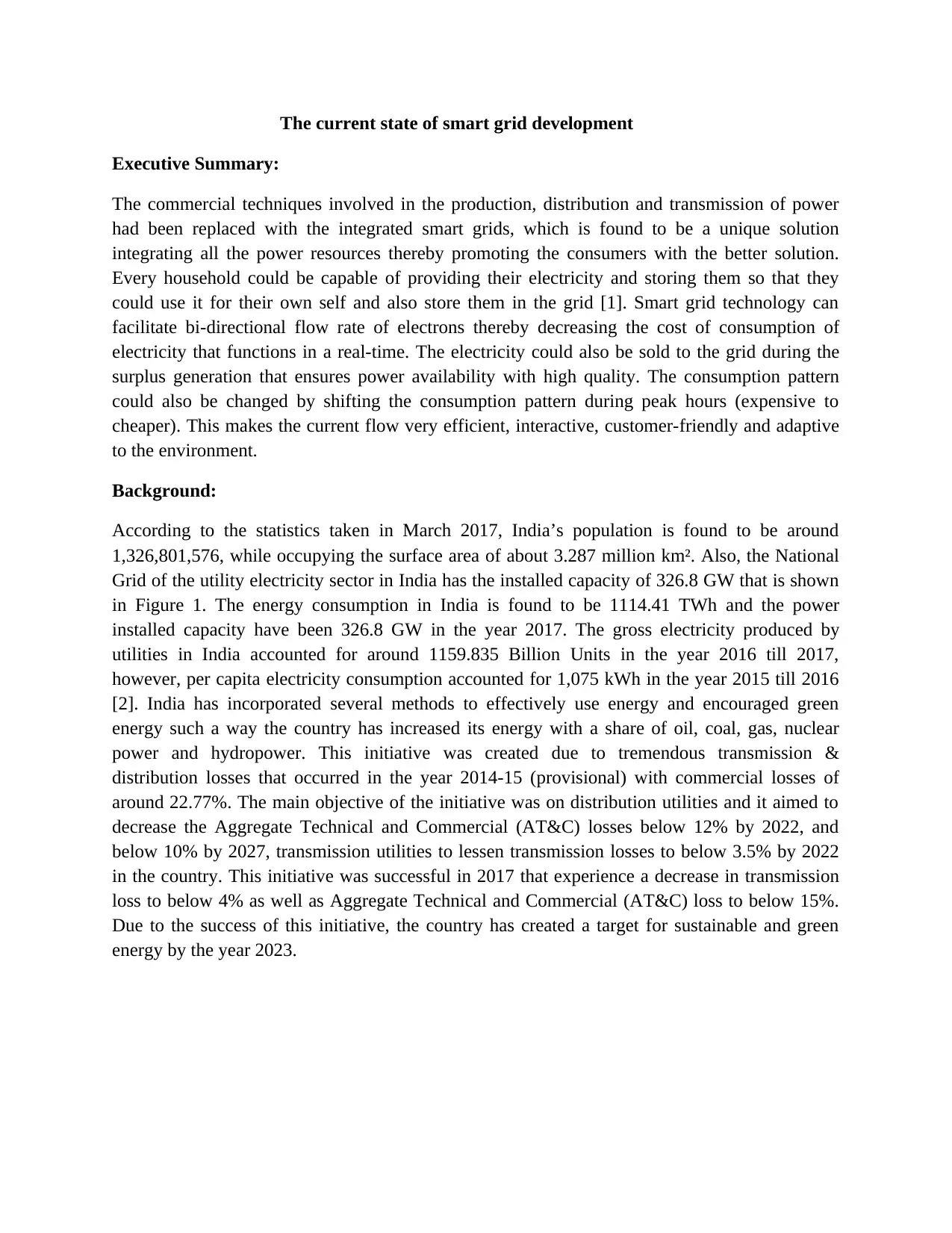
The current state of smart grid development
Executive Summary:
The commercial techniques involved in the production, distribution and transmission of power
had been replaced with the integrated smart grids, which is found to be a unique solution
integrating all the power resources thereby promoting the consumers with the better solution.
Every household could be capable of providing their electricity and storing them so that they
could use it for their own self and also store them in the grid [1]. Smart grid technology can
facilitate bi-directional flow rate of electrons thereby decreasing the cost of consumption of
electricity that functions in a real-time. The electricity could also be sold to the grid during the
surplus generation that ensures power availability with high quality. The consumption pattern
could also be changed by shifting the consumption pattern during peak hours (expensive to
cheaper). This makes the current flow very efficient, interactive, customer-friendly and adaptive
to the environment.
Background:
According to the statistics taken in March 2017, India’s population is found to be around
1,326,801,576, while occupying the surface area of about 3.287 million km². Also, the National
Grid of the utility electricity sector in India has the installed capacity of 326.8 GW that is shown
in Figure 1. The energy consumption in India is found to be 1114.41 TWh and the power
installed capacity have been 326.8 GW in the year 2017. The gross electricity produced by
utilities in India accounted for around 1159.835 Billion Units in the year 2016 till 2017,
however, per capita electricity consumption accounted for 1,075 kWh in the year 2015 till 2016
[2]. India has incorporated several methods to effectively use energy and encouraged green
energy such a way the country has increased its energy with a share of oil, coal, gas, nuclear
power and hydropower. This initiative was created due to tremendous transmission &
distribution losses that occurred in the year 2014-15 (provisional) with commercial losses of
around 22.77%. The main objective of the initiative was on distribution utilities and it aimed to
decrease the Aggregate Technical and Commercial (AT&C) losses below 12% by 2022, and
below 10% by 2027, transmission utilities to lessen transmission losses to below 3.5% by 2022
in the country. This initiative was successful in 2017 that experience a decrease in transmission
loss to below 4% as well as Aggregate Technical and Commercial (AT&C) loss to below 15%.
Due to the success of this initiative, the country has created a target for sustainable and green
energy by the year 2023.
Executive Summary:
The commercial techniques involved in the production, distribution and transmission of power
had been replaced with the integrated smart grids, which is found to be a unique solution
integrating all the power resources thereby promoting the consumers with the better solution.
Every household could be capable of providing their electricity and storing them so that they
could use it for their own self and also store them in the grid [1]. Smart grid technology can
facilitate bi-directional flow rate of electrons thereby decreasing the cost of consumption of
electricity that functions in a real-time. The electricity could also be sold to the grid during the
surplus generation that ensures power availability with high quality. The consumption pattern
could also be changed by shifting the consumption pattern during peak hours (expensive to
cheaper). This makes the current flow very efficient, interactive, customer-friendly and adaptive
to the environment.
Background:
According to the statistics taken in March 2017, India’s population is found to be around
1,326,801,576, while occupying the surface area of about 3.287 million km². Also, the National
Grid of the utility electricity sector in India has the installed capacity of 326.8 GW that is shown
in Figure 1. The energy consumption in India is found to be 1114.41 TWh and the power
installed capacity have been 326.8 GW in the year 2017. The gross electricity produced by
utilities in India accounted for around 1159.835 Billion Units in the year 2016 till 2017,
however, per capita electricity consumption accounted for 1,075 kWh in the year 2015 till 2016
[2]. India has incorporated several methods to effectively use energy and encouraged green
energy such a way the country has increased its energy with a share of oil, coal, gas, nuclear
power and hydropower. This initiative was created due to tremendous transmission &
distribution losses that occurred in the year 2014-15 (provisional) with commercial losses of
around 22.77%. The main objective of the initiative was on distribution utilities and it aimed to
decrease the Aggregate Technical and Commercial (AT&C) losses below 12% by 2022, and
below 10% by 2027, transmission utilities to lessen transmission losses to below 3.5% by 2022
in the country. This initiative was successful in 2017 that experience a decrease in transmission
loss to below 4% as well as Aggregate Technical and Commercial (AT&C) loss to below 15%.
Due to the success of this initiative, the country has created a target for sustainable and green
energy by the year 2023.
Secure Best Marks with AI Grader
Need help grading? Try our AI Grader for instant feedback on your assignments.
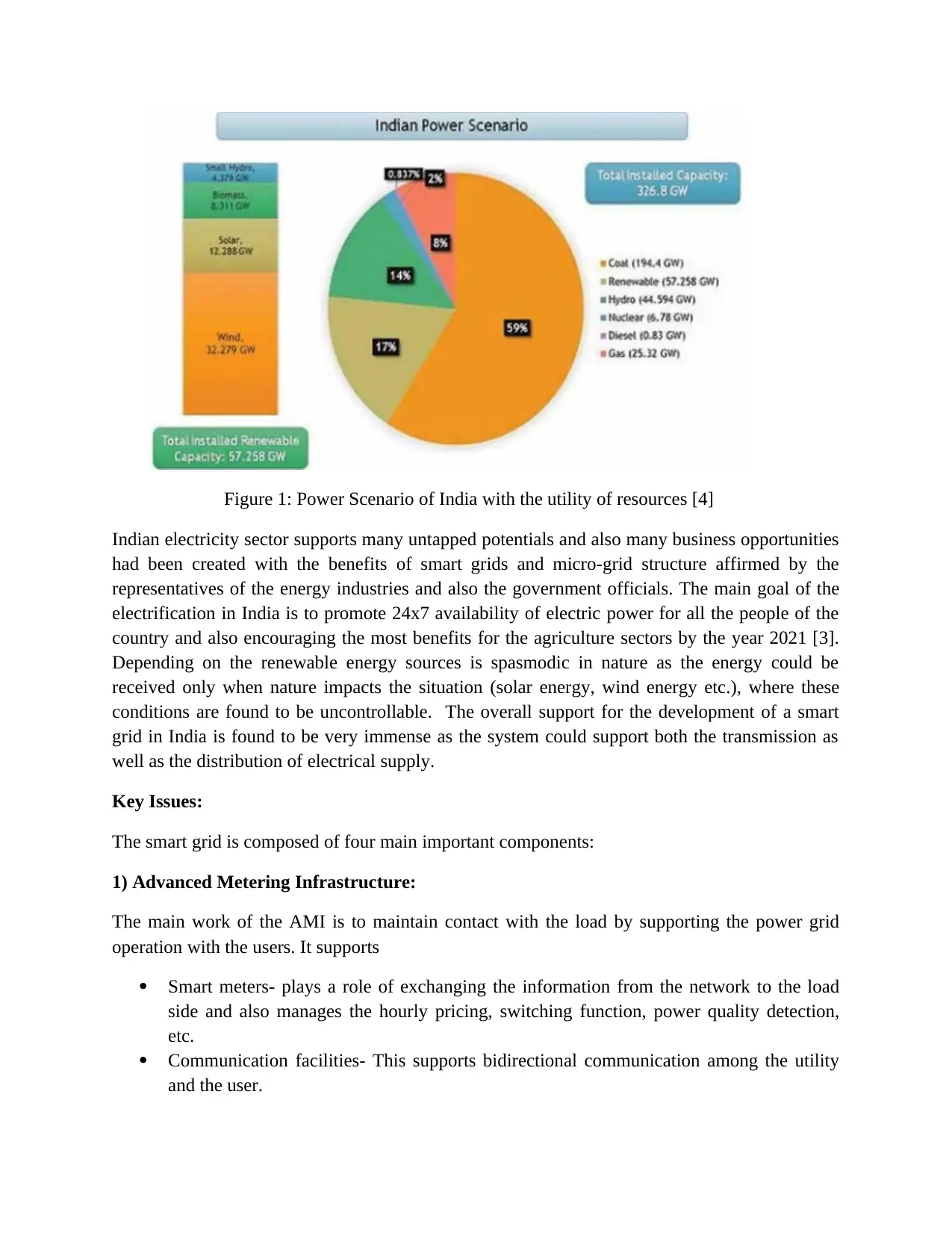
Figure 1: Power Scenario of India with the utility of resources [4]
Indian electricity sector supports many untapped potentials and also many business opportunities
had been created with the benefits of smart grids and micro-grid structure affirmed by the
representatives of the energy industries and also the government officials. The main goal of the
electrification in India is to promote 24x7 availability of electric power for all the people of the
country and also encouraging the most benefits for the agriculture sectors by the year 2021 [3].
Depending on the renewable energy sources is spasmodic in nature as the energy could be
received only when nature impacts the situation (solar energy, wind energy etc.), where these
conditions are found to be uncontrollable. The overall support for the development of a smart
grid in India is found to be very immense as the system could support both the transmission as
well as the distribution of electrical supply.
Key Issues:
The smart grid is composed of four main important components:
1) Advanced Metering Infrastructure:
The main work of the AMI is to maintain contact with the load by supporting the power grid
operation with the users. It supports
Smart meters- plays a role of exchanging the information from the network to the load
side and also manages the hourly pricing, switching function, power quality detection,
etc.
Communication facilities- This supports bidirectional communication among the utility
and the user.
Indian electricity sector supports many untapped potentials and also many business opportunities
had been created with the benefits of smart grids and micro-grid structure affirmed by the
representatives of the energy industries and also the government officials. The main goal of the
electrification in India is to promote 24x7 availability of electric power for all the people of the
country and also encouraging the most benefits for the agriculture sectors by the year 2021 [3].
Depending on the renewable energy sources is spasmodic in nature as the energy could be
received only when nature impacts the situation (solar energy, wind energy etc.), where these
conditions are found to be uncontrollable. The overall support for the development of a smart
grid in India is found to be very immense as the system could support both the transmission as
well as the distribution of electrical supply.
Key Issues:
The smart grid is composed of four main important components:
1) Advanced Metering Infrastructure:
The main work of the AMI is to maintain contact with the load by supporting the power grid
operation with the users. It supports
Smart meters- plays a role of exchanging the information from the network to the load
side and also manages the hourly pricing, switching function, power quality detection,
etc.
Communication facilities- This supports bidirectional communication among the utility
and the user.
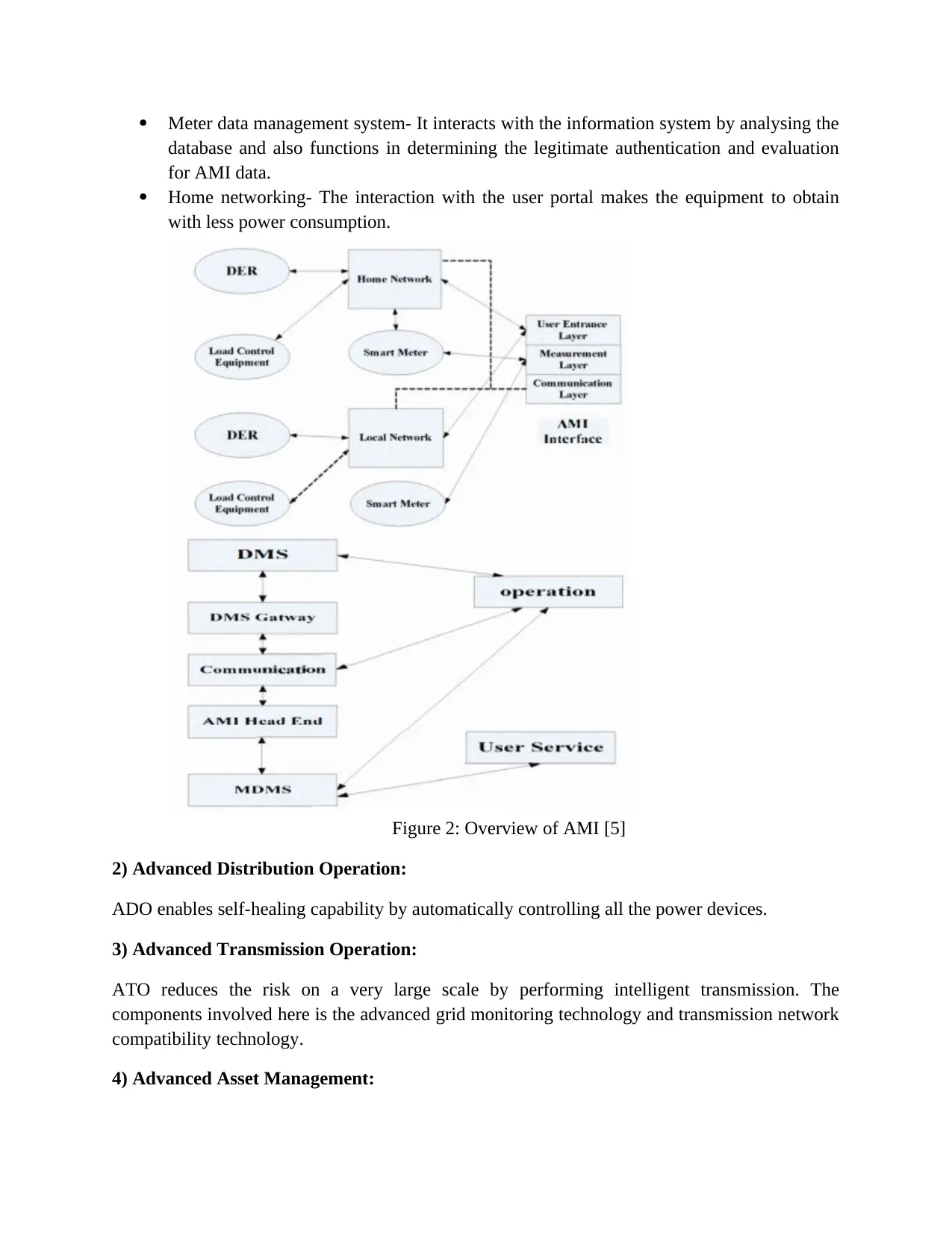
Meter data management system- It interacts with the information system by analysing the
database and also functions in determining the legitimate authentication and evaluation
for AMI data.
Home networking- The interaction with the user portal makes the equipment to obtain
with less power consumption.
Figure 2: Overview of AMI [5]
2) Advanced Distribution Operation:
ADO enables self-healing capability by automatically controlling all the power devices.
3) Advanced Transmission Operation:
ATO reduces the risk on a very large scale by performing intelligent transmission. The
components involved here is the advanced grid monitoring technology and transmission network
compatibility technology.
4) Advanced Asset Management:
database and also functions in determining the legitimate authentication and evaluation
for AMI data.
Home networking- The interaction with the user portal makes the equipment to obtain
with less power consumption.
Figure 2: Overview of AMI [5]
2) Advanced Distribution Operation:
ADO enables self-healing capability by automatically controlling all the power devices.
3) Advanced Transmission Operation:
ATO reduces the risk on a very large scale by performing intelligent transmission. The
components involved here is the advanced grid monitoring technology and transmission network
compatibility technology.
4) Advanced Asset Management:
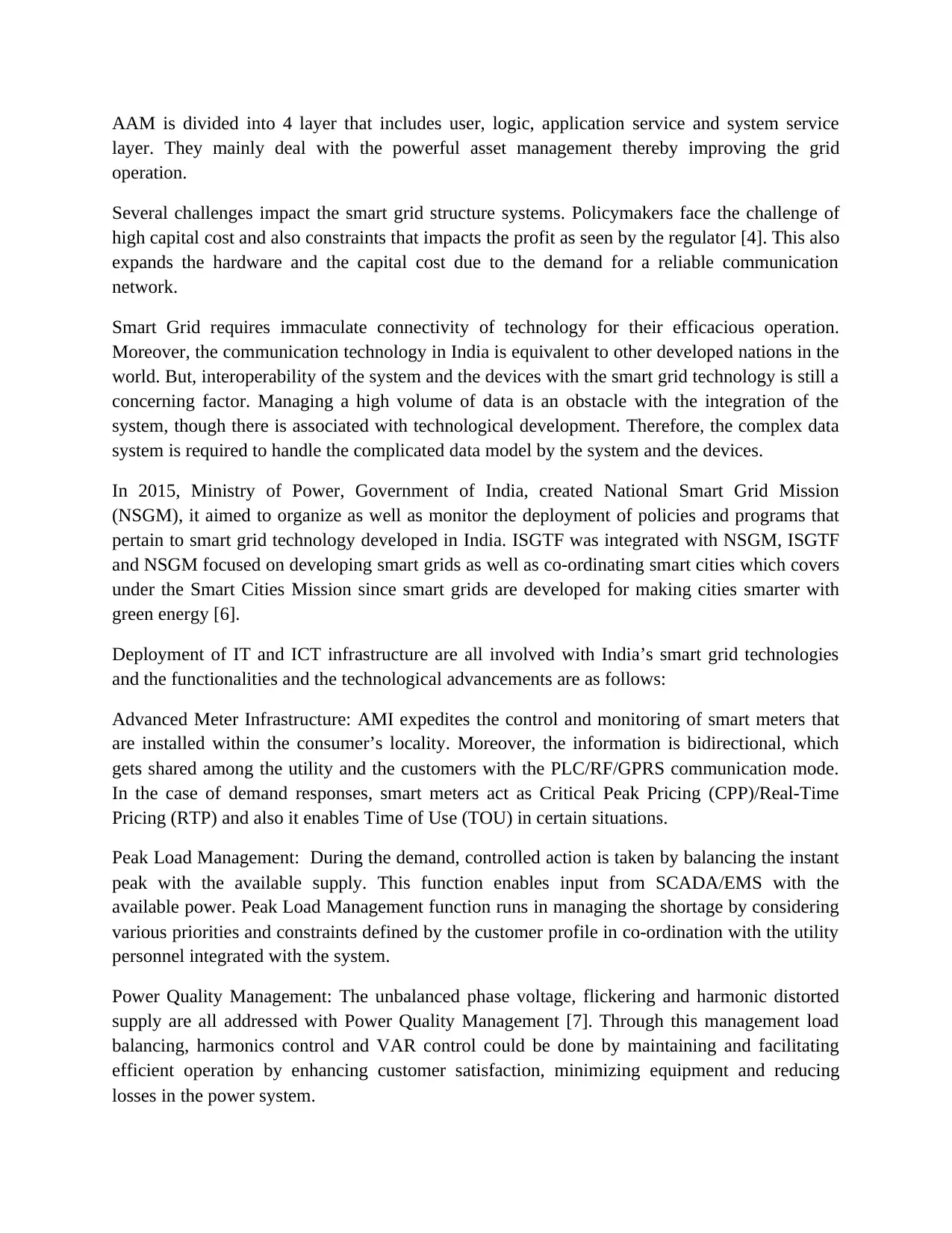
AAM is divided into 4 layer that includes user, logic, application service and system service
layer. They mainly deal with the powerful asset management thereby improving the grid
operation.
Several challenges impact the smart grid structure systems. Policymakers face the challenge of
high capital cost and also constraints that impacts the profit as seen by the regulator [4]. This also
expands the hardware and the capital cost due to the demand for a reliable communication
network.
Smart Grid requires immaculate connectivity of technology for their efficacious operation.
Moreover, the communication technology in India is equivalent to other developed nations in the
world. But, interoperability of the system and the devices with the smart grid technology is still a
concerning factor. Managing a high volume of data is an obstacle with the integration of the
system, though there is associated with technological development. Therefore, the complex data
system is required to handle the complicated data model by the system and the devices.
In 2015, Ministry of Power, Government of India, created National Smart Grid Mission
(NSGM), it aimed to organize as well as monitor the deployment of policies and programs that
pertain to smart grid technology developed in India. ISGTF was integrated with NSGM, ISGTF
and NSGM focused on developing smart grids as well as co-ordinating smart cities which covers
under the Smart Cities Mission since smart grids are developed for making cities smarter with
green energy [6].
Deployment of IT and ICT infrastructure are all involved with India’s smart grid technologies
and the functionalities and the technological advancements are as follows:
Advanced Meter Infrastructure: AMI expedites the control and monitoring of smart meters that
are installed within the consumer’s locality. Moreover, the information is bidirectional, which
gets shared among the utility and the customers with the PLC/RF/GPRS communication mode.
In the case of demand responses, smart meters act as Critical Peak Pricing (CPP)/Real-Time
Pricing (RTP) and also it enables Time of Use (TOU) in certain situations.
Peak Load Management: During the demand, controlled action is taken by balancing the instant
peak with the available supply. This function enables input from SCADA/EMS with the
available power. Peak Load Management function runs in managing the shortage by considering
various priorities and constraints defined by the customer profile in co-ordination with the utility
personnel integrated with the system.
Power Quality Management: The unbalanced phase voltage, flickering and harmonic distorted
supply are all addressed with Power Quality Management [7]. Through this management load
balancing, harmonics control and VAR control could be done by maintaining and facilitating
efficient operation by enhancing customer satisfaction, minimizing equipment and reducing
losses in the power system.
layer. They mainly deal with the powerful asset management thereby improving the grid
operation.
Several challenges impact the smart grid structure systems. Policymakers face the challenge of
high capital cost and also constraints that impacts the profit as seen by the regulator [4]. This also
expands the hardware and the capital cost due to the demand for a reliable communication
network.
Smart Grid requires immaculate connectivity of technology for their efficacious operation.
Moreover, the communication technology in India is equivalent to other developed nations in the
world. But, interoperability of the system and the devices with the smart grid technology is still a
concerning factor. Managing a high volume of data is an obstacle with the integration of the
system, though there is associated with technological development. Therefore, the complex data
system is required to handle the complicated data model by the system and the devices.
In 2015, Ministry of Power, Government of India, created National Smart Grid Mission
(NSGM), it aimed to organize as well as monitor the deployment of policies and programs that
pertain to smart grid technology developed in India. ISGTF was integrated with NSGM, ISGTF
and NSGM focused on developing smart grids as well as co-ordinating smart cities which covers
under the Smart Cities Mission since smart grids are developed for making cities smarter with
green energy [6].
Deployment of IT and ICT infrastructure are all involved with India’s smart grid technologies
and the functionalities and the technological advancements are as follows:
Advanced Meter Infrastructure: AMI expedites the control and monitoring of smart meters that
are installed within the consumer’s locality. Moreover, the information is bidirectional, which
gets shared among the utility and the customers with the PLC/RF/GPRS communication mode.
In the case of demand responses, smart meters act as Critical Peak Pricing (CPP)/Real-Time
Pricing (RTP) and also it enables Time of Use (TOU) in certain situations.
Peak Load Management: During the demand, controlled action is taken by balancing the instant
peak with the available supply. This function enables input from SCADA/EMS with the
available power. Peak Load Management function runs in managing the shortage by considering
various priorities and constraints defined by the customer profile in co-ordination with the utility
personnel integrated with the system.
Power Quality Management: The unbalanced phase voltage, flickering and harmonic distorted
supply are all addressed with Power Quality Management [7]. Through this management load
balancing, harmonics control and VAR control could be done by maintaining and facilitating
efficient operation by enhancing customer satisfaction, minimizing equipment and reducing
losses in the power system.
Secure Best Marks with AI Grader
Need help grading? Try our AI Grader for instant feedback on your assignments.
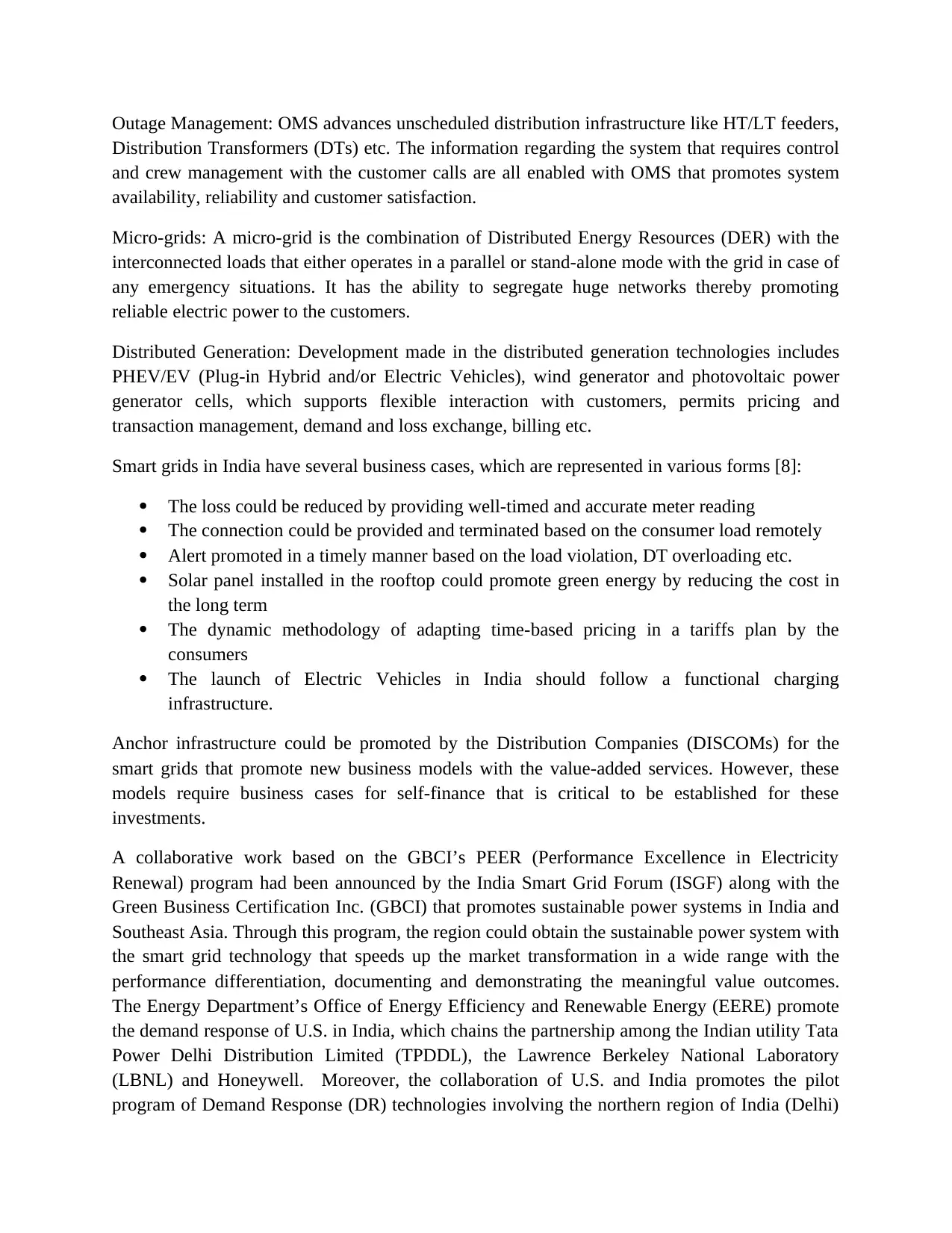
Outage Management: OMS advances unscheduled distribution infrastructure like HT/LT feeders,
Distribution Transformers (DTs) etc. The information regarding the system that requires control
and crew management with the customer calls are all enabled with OMS that promotes system
availability, reliability and customer satisfaction.
Micro-grids: A micro-grid is the combination of Distributed Energy Resources (DER) with the
interconnected loads that either operates in a parallel or stand-alone mode with the grid in case of
any emergency situations. It has the ability to segregate huge networks thereby promoting
reliable electric power to the customers.
Distributed Generation: Development made in the distributed generation technologies includes
PHEV/EV (Plug-in Hybrid and/or Electric Vehicles), wind generator and photovoltaic power
generator cells, which supports flexible interaction with customers, permits pricing and
transaction management, demand and loss exchange, billing etc.
Smart grids in India have several business cases, which are represented in various forms [8]:
The loss could be reduced by providing well-timed and accurate meter reading
The connection could be provided and terminated based on the consumer load remotely
Alert promoted in a timely manner based on the load violation, DT overloading etc.
Solar panel installed in the rooftop could promote green energy by reducing the cost in
the long term
The dynamic methodology of adapting time-based pricing in a tariffs plan by the
consumers
The launch of Electric Vehicles in India should follow a functional charging
infrastructure.
Anchor infrastructure could be promoted by the Distribution Companies (DISCOMs) for the
smart grids that promote new business models with the value-added services. However, these
models require business cases for self-finance that is critical to be established for these
investments.
A collaborative work based on the GBCI’s PEER (Performance Excellence in Electricity
Renewal) program had been announced by the India Smart Grid Forum (ISGF) along with the
Green Business Certification Inc. (GBCI) that promotes sustainable power systems in India and
Southeast Asia. Through this program, the region could obtain the sustainable power system with
the smart grid technology that speeds up the market transformation in a wide range with the
performance differentiation, documenting and demonstrating the meaningful value outcomes.
The Energy Department’s Office of Energy Efficiency and Renewable Energy (EERE) promote
the demand response of U.S. in India, which chains the partnership among the Indian utility Tata
Power Delhi Distribution Limited (TPDDL), the Lawrence Berkeley National Laboratory
(LBNL) and Honeywell. Moreover, the collaboration of U.S. and India promotes the pilot
program of Demand Response (DR) technologies involving the northern region of India (Delhi)
Distribution Transformers (DTs) etc. The information regarding the system that requires control
and crew management with the customer calls are all enabled with OMS that promotes system
availability, reliability and customer satisfaction.
Micro-grids: A micro-grid is the combination of Distributed Energy Resources (DER) with the
interconnected loads that either operates in a parallel or stand-alone mode with the grid in case of
any emergency situations. It has the ability to segregate huge networks thereby promoting
reliable electric power to the customers.
Distributed Generation: Development made in the distributed generation technologies includes
PHEV/EV (Plug-in Hybrid and/or Electric Vehicles), wind generator and photovoltaic power
generator cells, which supports flexible interaction with customers, permits pricing and
transaction management, demand and loss exchange, billing etc.
Smart grids in India have several business cases, which are represented in various forms [8]:
The loss could be reduced by providing well-timed and accurate meter reading
The connection could be provided and terminated based on the consumer load remotely
Alert promoted in a timely manner based on the load violation, DT overloading etc.
Solar panel installed in the rooftop could promote green energy by reducing the cost in
the long term
The dynamic methodology of adapting time-based pricing in a tariffs plan by the
consumers
The launch of Electric Vehicles in India should follow a functional charging
infrastructure.
Anchor infrastructure could be promoted by the Distribution Companies (DISCOMs) for the
smart grids that promote new business models with the value-added services. However, these
models require business cases for self-finance that is critical to be established for these
investments.
A collaborative work based on the GBCI’s PEER (Performance Excellence in Electricity
Renewal) program had been announced by the India Smart Grid Forum (ISGF) along with the
Green Business Certification Inc. (GBCI) that promotes sustainable power systems in India and
Southeast Asia. Through this program, the region could obtain the sustainable power system with
the smart grid technology that speeds up the market transformation in a wide range with the
performance differentiation, documenting and demonstrating the meaningful value outcomes.
The Energy Department’s Office of Energy Efficiency and Renewable Energy (EERE) promote
the demand response of U.S. in India, which chains the partnership among the Indian utility Tata
Power Delhi Distribution Limited (TPDDL), the Lawrence Berkeley National Laboratory
(LBNL) and Honeywell. Moreover, the collaboration of U.S. and India promotes the pilot
program of Demand Response (DR) technologies involving the northern region of India (Delhi)

with the enrolled peak load of 25 MW in 167 buildings. This field test carried out in India serves
as a platform for assessing the capacity of the suppliers and technology, obtaining the user's
benefits, evaluating regulatory readiness, and promoting product specifications before upraising
the Smart Grid plans and detailed DR with the other states and territories in India.
Importance and Impacts:
Cyber Security
Government and other business organization face critical trouble with the cyber security.
Through the Information Technology Act-2000, Government of India (GOI) decided to
implement the compliances, guidance and cyber security standards with the Indian Computer
Emergency Response Team (CERT-ln). Four sectoral CERTs in MOI had been created with the
GOI: 1) CERT - Thermal – NTPC 2) CERT - Hydro – NHPC 3) CERT - Transmission –
POWERGRID and finally 4) CERT - Distribution - DP&D Division. Moreover, the National
Critical Information Infrastructure Protection Centre (NCIIPC) had also been created by the GOI
with the Information Technology Act-2000. Various cyber security incidents taking place in the
power sectors had been analyzed with the central coordinating agency through the Information
Sharing and Analysis Centre (ISAC-Power) that severs as a common platform under the CERTs
Ministry of power.
Conclusion and Recommendations:
The country has paved a way for the intelligent smart metering according to the CEA guidelines
and Restructured Accelerated Power Development and Reform Program (R-APDRP). The
present rate of a smart meter is around US$ 340.82 million and it is expected to increase by 10%
in the next 5 years at a Compound Annual Growth Rate (CAGR). Moreover, UDAY- a scheme
for the financial and operational turnover of DISCOMS calculated to install 35 million smart
meters by the year of 2020. India had exported 400,000 of its electric supply to Australia and
over 50,000 meters to Malaysia, the UK, and the UAE. Several personal information is promoted
by the smart grid system and certain vulnerable activities may lead to data leakage that affects
the privacy of the user. Moreover, the information exchanges all lies within the smart grid and it
forms as a base in carrying our several innovations and investment.
References:
as a platform for assessing the capacity of the suppliers and technology, obtaining the user's
benefits, evaluating regulatory readiness, and promoting product specifications before upraising
the Smart Grid plans and detailed DR with the other states and territories in India.
Importance and Impacts:
Cyber Security
Government and other business organization face critical trouble with the cyber security.
Through the Information Technology Act-2000, Government of India (GOI) decided to
implement the compliances, guidance and cyber security standards with the Indian Computer
Emergency Response Team (CERT-ln). Four sectoral CERTs in MOI had been created with the
GOI: 1) CERT - Thermal – NTPC 2) CERT - Hydro – NHPC 3) CERT - Transmission –
POWERGRID and finally 4) CERT - Distribution - DP&D Division. Moreover, the National
Critical Information Infrastructure Protection Centre (NCIIPC) had also been created by the GOI
with the Information Technology Act-2000. Various cyber security incidents taking place in the
power sectors had been analyzed with the central coordinating agency through the Information
Sharing and Analysis Centre (ISAC-Power) that severs as a common platform under the CERTs
Ministry of power.
Conclusion and Recommendations:
The country has paved a way for the intelligent smart metering according to the CEA guidelines
and Restructured Accelerated Power Development and Reform Program (R-APDRP). The
present rate of a smart meter is around US$ 340.82 million and it is expected to increase by 10%
in the next 5 years at a Compound Annual Growth Rate (CAGR). Moreover, UDAY- a scheme
for the financial and operational turnover of DISCOMS calculated to install 35 million smart
meters by the year of 2020. India had exported 400,000 of its electric supply to Australia and
over 50,000 meters to Malaysia, the UK, and the UAE. Several personal information is promoted
by the smart grid system and certain vulnerable activities may lead to data leakage that affects
the privacy of the user. Moreover, the information exchanges all lies within the smart grid and it
forms as a base in carrying our several innovations and investment.
References:

[1] “Smart Grid Vision for India”, Ministry of Power (MoP), Govt. of India, August, 2013
[2] S. Padmanaban & Ashok Sarkar, “Electricity Demand Side Management (DSM) In
India –A Strategic And Policy Perspective”, Office of Environment, Energy And
Enterprise, US Agency for International Development, Ne w Delhi , Indi a.
Available Online:
http://www.energymanagertraining.com/DSM/ElectricityDemandSideManagement.doc.
[3] “Energy Efficiency Technologies-World Energy Council (WEC)”, World Energy
Council 2014. Available Online on official website of WEC : www.worldenergy.org
[4] https://www.nsgm.gov.in/en/content/smart-grid
[5] Zhou Xue-song, Cui Li-qiang and Ma You-jie, "Research on smart grid technology,"
2010 International Conference on Computer Application and System Modeling
(ICCASM 2010), Taiyuan, 2010, pp. V3-599-V3-603.
[6] United States Department of Energy Office of Electric Transmission and Distribution
The smart grid : An introduction[EB/OL ].
[7] Mini S. Thomas, Seema Arora, Vinay Kumar Chandna, "Distribution automation leading
to a smarter grid", Innovative Smart Grid Technologies - India (ISGT India) 2011 IEEE
PES, pp. 211-216, 2011.
[8] M. Amin Toward self-healing energy infrastructure systems[J]. IEEE Computer
Applications in Power, 2001, 14(1): 20-28.
[2] S. Padmanaban & Ashok Sarkar, “Electricity Demand Side Management (DSM) In
India –A Strategic And Policy Perspective”, Office of Environment, Energy And
Enterprise, US Agency for International Development, Ne w Delhi , Indi a.
Available Online:
http://www.energymanagertraining.com/DSM/ElectricityDemandSideManagement.doc.
[3] “Energy Efficiency Technologies-World Energy Council (WEC)”, World Energy
Council 2014. Available Online on official website of WEC : www.worldenergy.org
[4] https://www.nsgm.gov.in/en/content/smart-grid
[5] Zhou Xue-song, Cui Li-qiang and Ma You-jie, "Research on smart grid technology,"
2010 International Conference on Computer Application and System Modeling
(ICCASM 2010), Taiyuan, 2010, pp. V3-599-V3-603.
[6] United States Department of Energy Office of Electric Transmission and Distribution
The smart grid : An introduction[EB/OL ].
[7] Mini S. Thomas, Seema Arora, Vinay Kumar Chandna, "Distribution automation leading
to a smarter grid", Innovative Smart Grid Technologies - India (ISGT India) 2011 IEEE
PES, pp. 211-216, 2011.
[8] M. Amin Toward self-healing energy infrastructure systems[J]. IEEE Computer
Applications in Power, 2001, 14(1): 20-28.
1 out of 7
Related Documents
Your All-in-One AI-Powered Toolkit for Academic Success.
+13062052269
info@desklib.com
Available 24*7 on WhatsApp / Email
![[object Object]](/_next/static/media/star-bottom.7253800d.svg)
Unlock your academic potential
© 2024 | Zucol Services PVT LTD | All rights reserved.





